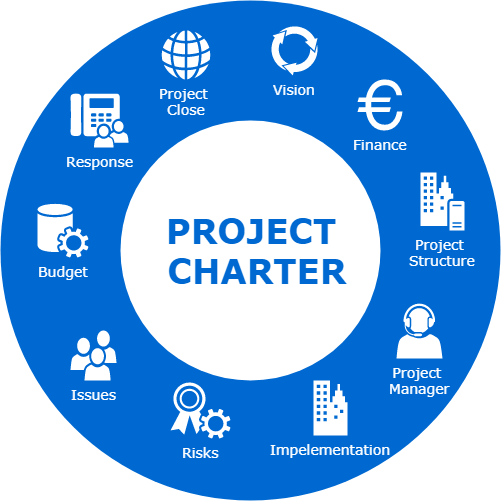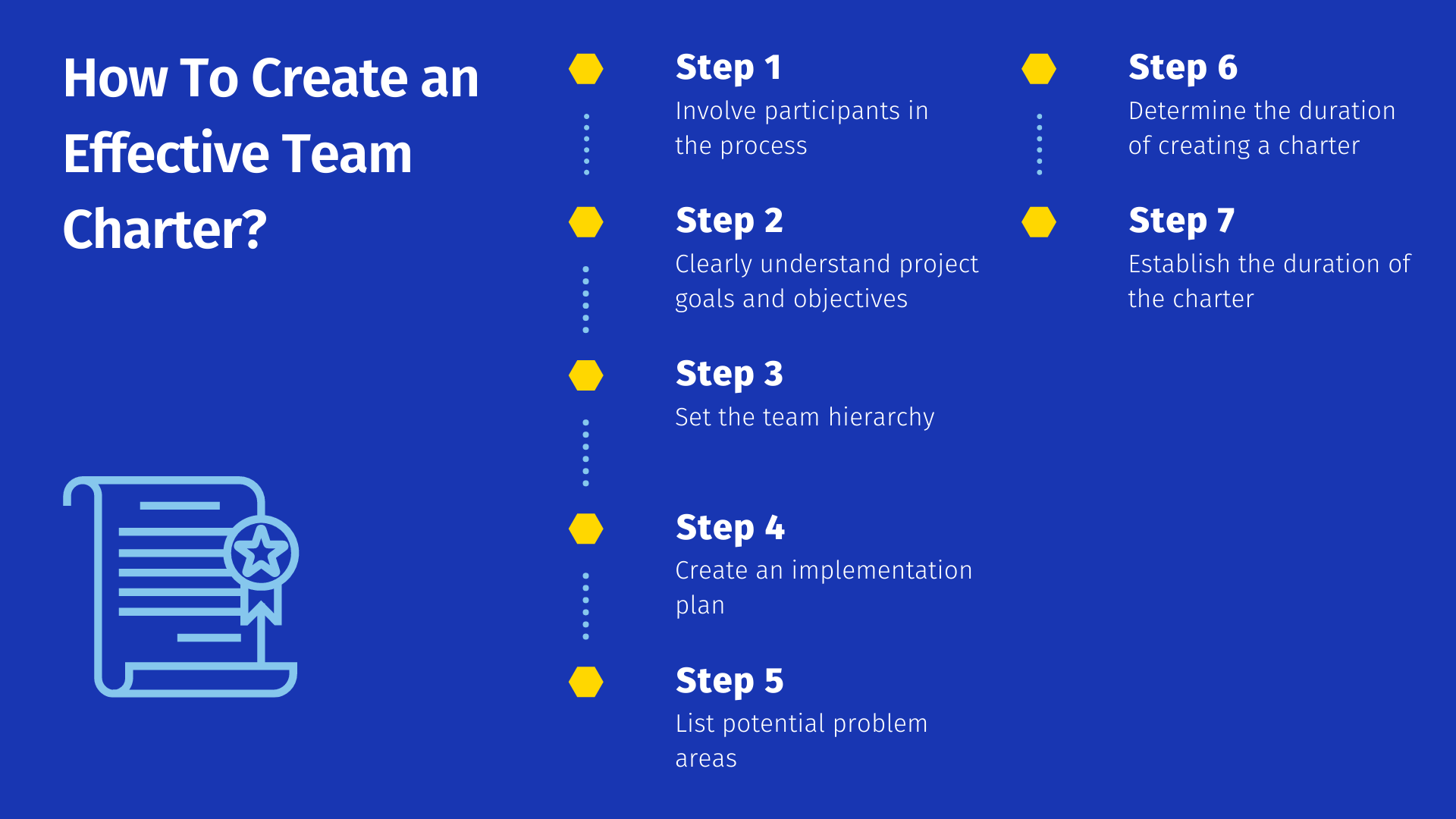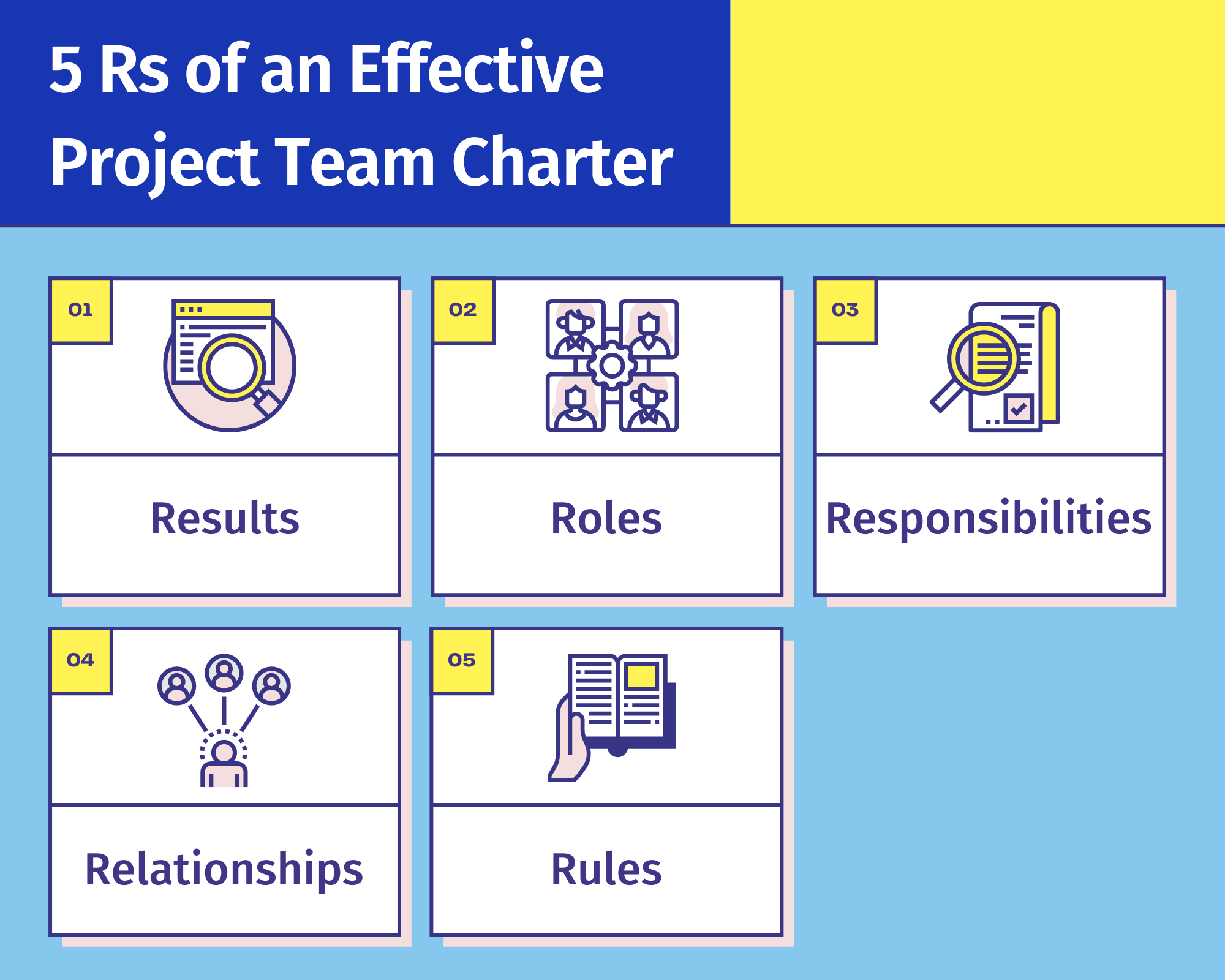5 Rs of an Effective Project Team Charter and How to Create One
Every project team needs a project team charter, which allows them to work in harmony to effectively and cohesively ensure project success. A team charter serves as a blueprint for team members to illustrate the team’s focus and direction, visualize the project’s business value, and gain team members’ buy-in. Teams working on long-term projects can use a project team charter to recharge, regroup, and refocus. Including all team members in the creation of a project team charter improves team members’ motivation, buy-in, and project accountability.
What Is a Project Charter?
A project charter is a document that officially kicks off a project. It formally authorizes the existence of the project and provides a reference for the future. The charter offers a Project Manager direction and a sense of purpose from start to finish. A project charter is a formal, short, written document containing every piece of information about a project, including:

Source: Mudassir Iqbal
- The team’s mission
- Scope of operation
- Project objectives
- Milestones and guidelines
- Project roadmap
- Unique project characteristics
- Timeframe (if applicable)
- Project benefits
- Budget and spending authority
- Roles of the Project Manager and team members
- Stakeholder information
A team charter is vital when planning a project and is used throughout the project lifecycle. During the creation of a charter, each team member should provide inputs about their role. With a team charter, you can easily pinpoint individuals’ responsibilities to achieve a shared goal and get team member buy-in.
How To Create an Effective Team Charter?
A project team charter serves as a crucial roadmap to execute project activities and helps focus, prioritize, value, and finish the project efficiently. To ensure successful teamwork, it is essential that every individual actively participates.
These aspects must be considered when creating an effective project team charter:
1. Involve participants in the process. Every individual on a team should be involved in project charter creation and provide their inputs. Make a list of all the essential roles for the project, including consumers, stakeholders, and the day-to-day project team, and involve everyone in the process.
2. Clearly understand project goals and objectives. Everyone should be on the same page, identify the project vision, determine the scope of the project, and adhere to the goals and objectives.
3. Set the team hierarchy. Teams must decide early on, who will serve as the team leader, who will be second in command, and so on. For larger teams, there might be leaders over different subject areas. The team hierarchy should be included in the charter.

4. Create an implementation plan. A charter must contain the major milestones, dependencies, and a timeline for the whole development team and stakeholders.
5. List potential problem areas. To develop a realistic charter, consider every possible disruption, calculate buffer timing to resolve issues, and identify an authority who will take responsibility. Adding potential risks and issues to the team charter may help forward-thinking and even prevent potential roadblocks.
6. Determine the duration of creating a charter. The duration of a charter creation process depends on project size, team size, and other considerations. It is essential that all team members contribute to the charter. Once the charter is ready, everyone must be comfortable signing it and proceeding with the work outlined within it.
7. Establish the duration of the charter. The duration of the charter depends on the team. A team can decide to have a project-wide charter or a charter to cover all work for a quarter, year, or longer, with occasional check-ins as needed.
5 Rs of an Effective Project Team Charter
According to the 2017 Project Management Body of Knowledge (PMBOK®) Guide (page 307), Project Resource Management includes processes (identify, acquire, and manage) that ensure the Project Manager and project team have the necessary resources to produce a successful project. The most critical resource for a Project Manager is an efficient and responsible project team.
Once the appropriate team is formed, a project team charter must be created to establish “team values, agreements, and operating guidelines, decision-making criteria, conflict resolution processes, and meeting guidelines.” (PMBOK Guide, 2017) This critical project management document is an output of Project Resource Management Planning, which functions as a project team’s North Star.
There are five fundamental components of a project team charter: Results, Roles, Responsibilities, Relationships, and Rules (5 Rs).
1. Results: The most important component of a charter is the scope of the project, which includes a clear definition of the expected results (in terms of deliverables/products/services) of the project, how these results align with business goals, and strategic objectives. Based on the expected outcomes, you must define expectations from individual project team members. Each team member must understand how the project supports organizational objectives and how their efforts support team objectives.
2. Roles: Roles provide a clear definition of individual team members' participation based on the identified individual outcomes. A role is a function assigned to a project team member, such as an engineer, business analyst, testing coordinator, product owner, or team facilitator.

3. Responsibilities: Each team member has assigned responsibilities (duties and expected work) that they must perform to complete project activities. After an individual's responsibility assignment, a Project Manager's responsibility is to work with the project team and identify gaps and redundancies (if any) in team member roles and responsibilities.
4. Relationships: It is essential to predefine the necessary relationships between project team members and stakeholders to ensure a project runs smoothly. Relationships may include:
- Who is the concerned person from whom team members can acquire resources to accomplish their day-to-day tasks?
- Who will be the coordinators? To whom do team members provide resources (e.g., information, products) for others to perform their tasks?
Determining internal relationships to the project team and external relationships with stakeholders helps team members clearly understand the framework.
5. Rules: For collaborative work, it is essential to set ground rules (or a code of conduct) to denote project team members' expectations regarding acceptable behavior. To set ground rules for a project team, you need to consider every individual role, responsibility, and relationship. Rules of a project team must focus on communication guidelines, meeting guidelines, ethical obligations, decision-making criteria, conflict resolution, and other aspects of the project team charter.
Every team member should participate, provide input, and agree with the ground rules, with guidance from the Project Manager as needed.
Project Team Charter Example
To get a better understanding, let’s consider a sample project team charter. Though different organizations or teams prefer different project charter templates, the essential components remain the same in most cases. Here’s an example of a simple project team charter.
Company XYZ Project Charter
Project Name: Interactive Voice Response (IVR) project
Project Description: Introduce a new automated telephone system to ensure all calls are answered.
Business Case: Supports these company-wide goals:
- Increasing orders of sales team members by 20% from the current level
- Minimizing the number of unhandled calls to 0%
- Increasing customer satisfaction by 10 points
Project Deliverables: An IVS system to Unhandled calls per day
- Assist the sales team
- Provide training for the sales team
- Support the sales team during the first operational month of the system
Project Benefits:
| KPI | Baseline | Goal |
| Orders per salesperson per day | 20 | 24 |
| Unhandled calls per day | 11 | 0 |
| Customer satisfaction | 17 | 27 |
Project Risks:
No team members have previous experience of IVR setup, so there is a chance of an underestimation of the amount of work involved.
Project Budget:
Not to exceed $ABC
Project Milestones:
- Completion of IVR system development: October 15, 2020
- Last Revision Date: October 26, 2020
- Go live: November 1, 2020
Project Team Members:
- Project Manager: Alice Michaels
- Designer: Greta K.
- Developer: Jason B.
- Quality Assurance member: Safiya M.
Conclusion
The creation of a project team charter is a major responsibility of a Project Management professional. To efficiently manage project activities and a project team, the Project Management Professional (PMP) certification training plays a significant role. GreyCampus, a Project Management Institute (PMI) Authorized Training Partner, offers a training program for practicing project managers eager to take the PMP certification exam from PMI.
GreyCampus helps you enhance your preparation efforts with an effective study plan, official PMI study materials, selected practice questions, and simulated tests. Here you can get advice from PMP-certified instructors, which will provide you with an excellent learning experience. At GreyCampus, you will learn from PMP-trained instructors, who are evaluated and qualified by PMI to teach the updated PMP curriculum.
Want To Track Objectives With a Project Team Charter? Sign Up for a Bootcamp Today!
